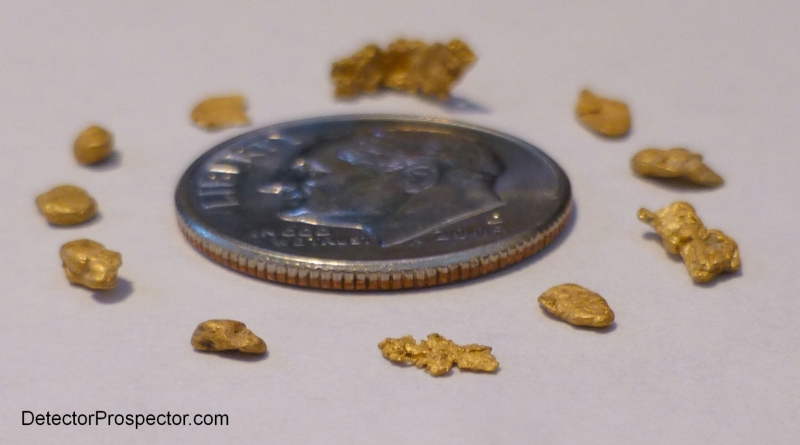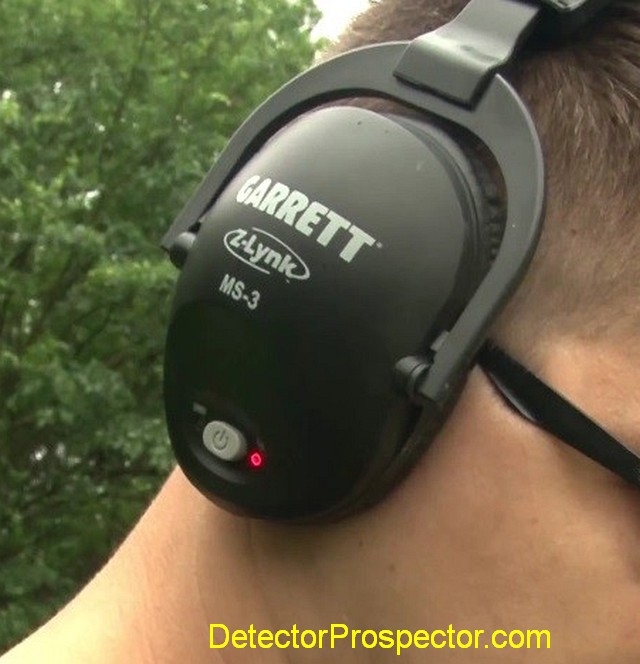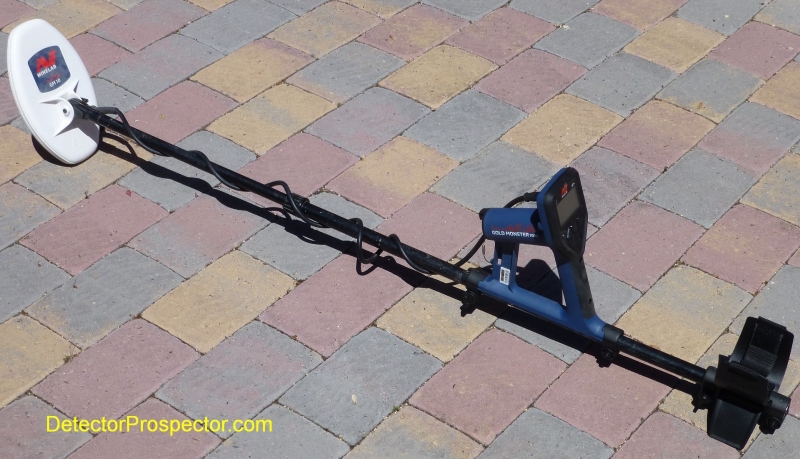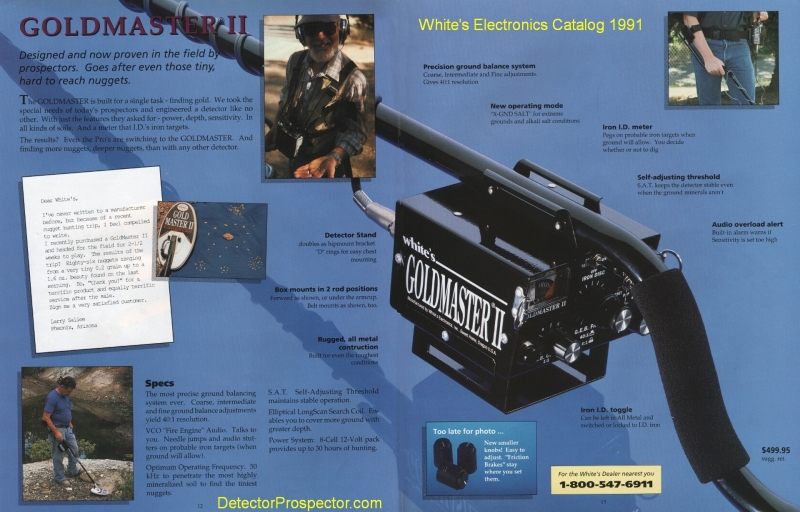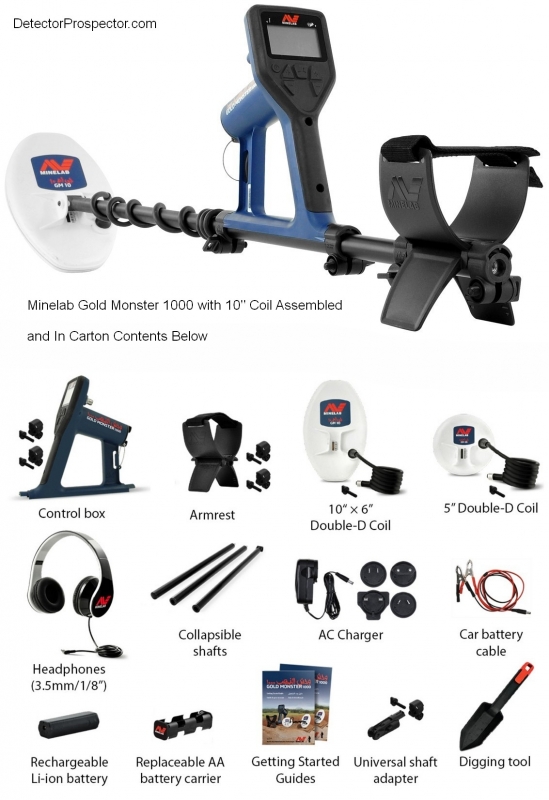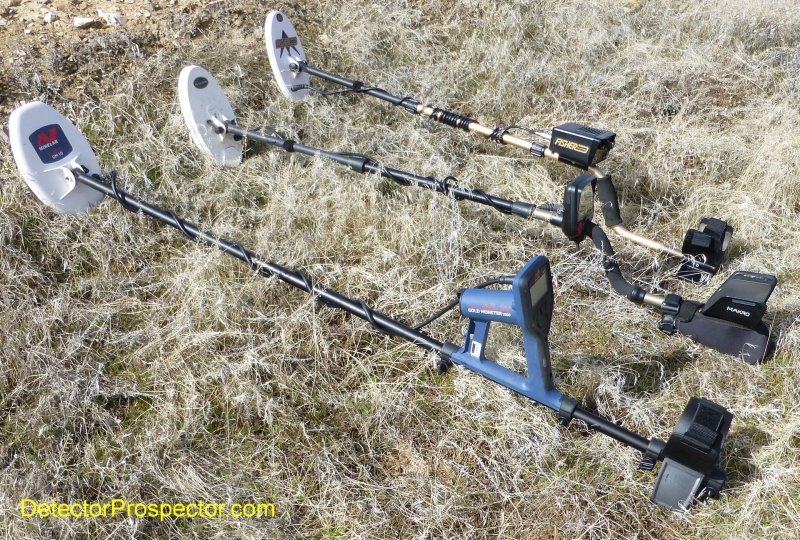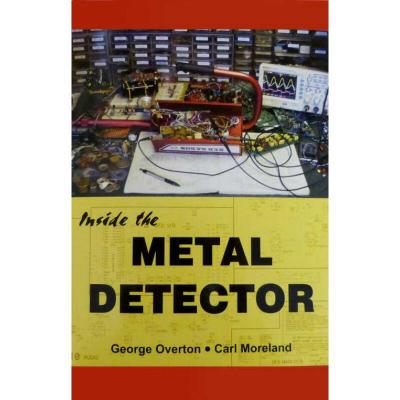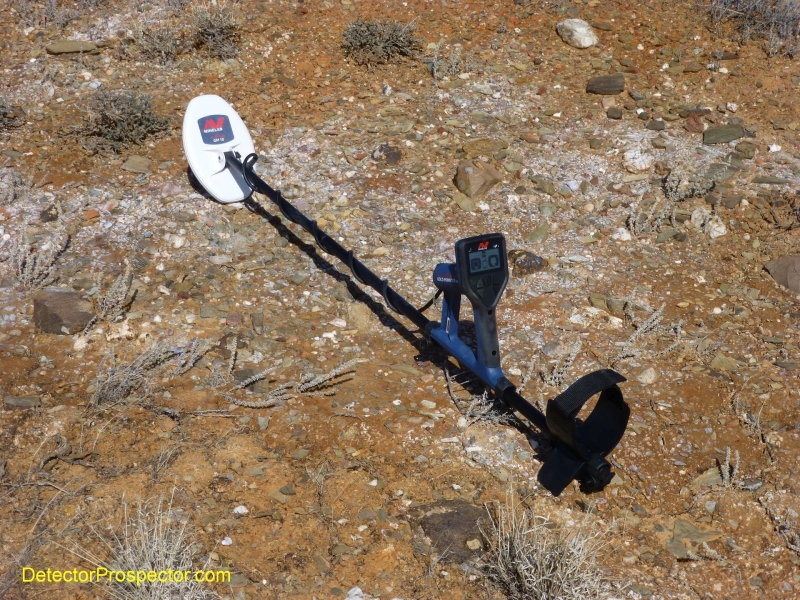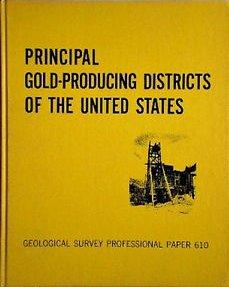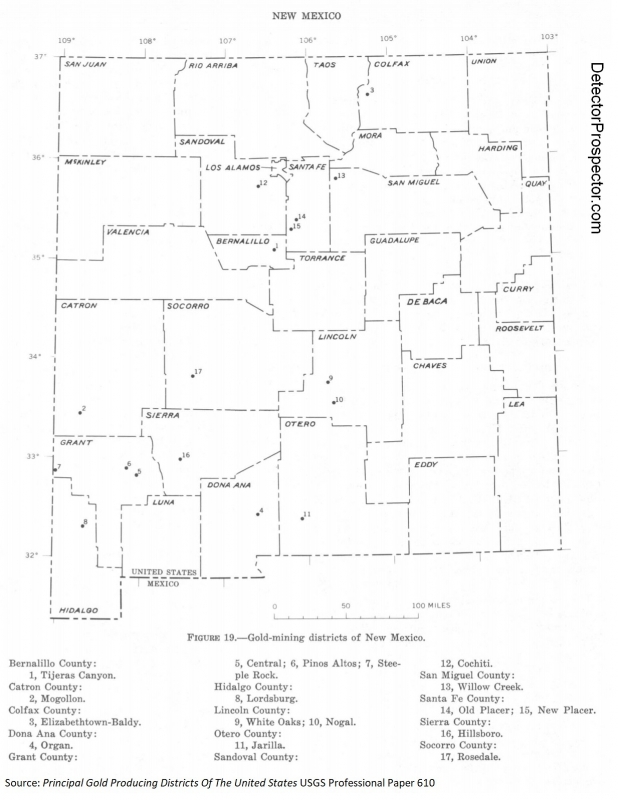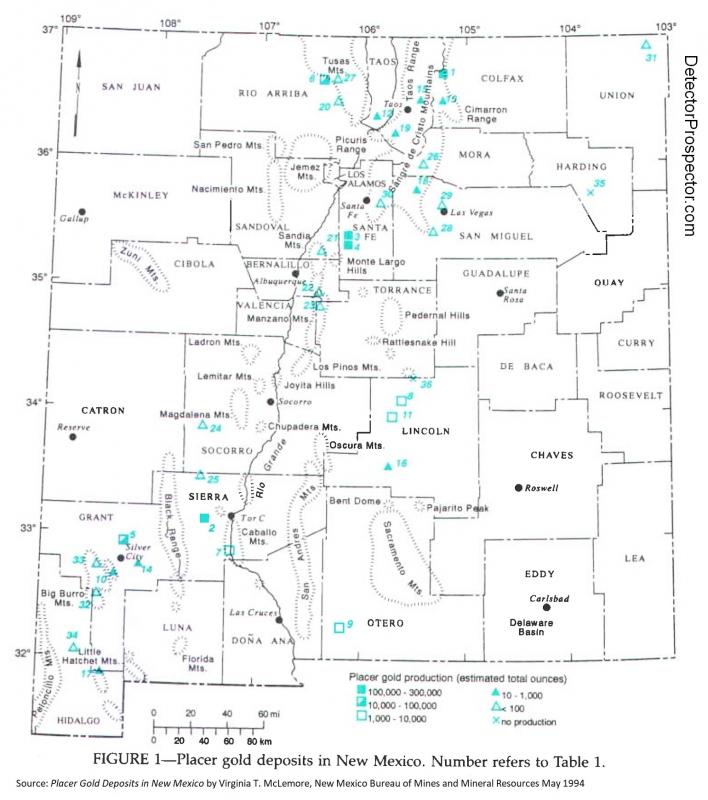-
Posts
19,756 -
Joined
Content Type
Forums
Detector Prospector Home
Detector Database
Downloads
Everything posted by Steve Herschbach
-
I have to admit that what with all my playing with VLF detectors as of late it really is just playing. Literally playing with detectors. But when the time finally comes to get down and dirty serious gold prospecting I will be running my GPZ 7000 day in and day out. It has been fun finding some tiny bits with the GM1000, and surely a joy to swing 3.5 lbs instead of twice that. Fun! But every moment swinging that 6" x 10" coil I am cognizant of just how little soil volume is being processed per swing as compared to my Zed 13" x 14" coil with the power behind it. Apples to oranges for sure, but reality nonetheless. The GM1000 would shine in some of my old haunts in Alaska, where a half gram nugget is a monster and the rain never stops. I know one spot...... Closeup of thin 0.3 grain gold flake center bottom, found with GM1000. Click for larger version.
-
-
Garrett claims to have improved the salt water handling with the new AT Max model. Bottom line is the AT Max is a single frequency VLF so no reason to get overly excited. However, improved salt water stability over the existing AT models will no doubt be welcome.
-
Mike, if you look at that join in my picture above, there is a o-ring visible. Not so visible is a large flat rubber washer just to the left of it in the photo, that forms a gasket between sections. Here it is better lit - click for larger version... If you half heartedly screw the section together and then bang the coil around a lot it could loosen and twist. You need to screw the sections together enough for that gasket to squash slightly, making for a very tight joint. It really is near impossible to do this properly with just the bare shaft in hand. I mounted the control box and coil, then used them to get enough leverage to get it tight. Of course when I took it apart removing control box and coil first, I could not get the rod sections apart with just bare hands. You either do things in the right order, have stronger hands than I (probably would not take much!) or use some sort of soft clamping tools. I think it is best set up as a stay in one piece unit with rod sections firmly screwed together, or go to a standard telescoping rod setup like I have done. The unit is as tippy as dozens of other VLF detectors - Fishers, Garretts, other Minelab's, etc. No better or worse. That was always a big plus for the Whites horizontal metal box design. My DFX stays upright, everything else falls over. In the photo below the Impact is slightly more stable than the other three, which are a toss up for tipping. Trivia question. Which unit below can be operated without worry in the rain without a rain cover?
-
I saw that post also, not sure if it is just that dealer, or just Oz, or everywhere. Three more weeks.... Anyway, the Gold Monster 1000 comes with a three piece rod that screws together to form a single 53" long rod. Well made, but I like a telescoping rod myself. I dug out an old Minelab GP upper shaft and lower rod, works great! Same as used on GPX at this time: Minelab Straight Upper Shaft for Gold Detectors 3011-0182 US$45.00 Minelab Lower Pole for various Minelab Metal Detectors 3011-0172 US$42.00 Note that you can't just take the GM1000 lower rod and plug it into some other upper shaft assembly due to the flange on top. Otherwise it might fit. Total weight on my postal scales with AA batteries installed 3 lbs 6.7 oz (3.42 lbs) or 1550 grams. I like it - it will stay on this rod. I did briefly look at a straight two piece upper shaft with the knurled tightening knob in the middle, but to get proper spacing the GM1000 control box wanted to be clamped down right over the knob and so that will not work - or at least that particular one was not spaced right. If two piece upper shaft you need the upper most section to have at least 20" free and clear to mount the control box and armrest.
-
I have said in the past that the GPZ 7000 is like a "Super VLF" in the way it operates and reacts, but with the PI dual tone twist. If I gave you the impression however that a Gold Monster 1000 handles variable ground better than a GPZ 7000 that is dead wrong. I am talking about in comparison to other "high frequency" induction balance detectors running at 30 kHz and higher. The only situation where a GM1000 beats a GPZ 7000 is in A. hitting tiny sub-grain bits of gold and B. employing ferrous discrimination if needed. But for sheer depth in bad ground the GPZ 7000 is just going to blow the GM1000 away. I will still be using a GPZ 7000 for nearly all my detecting. The GM1000 will be for more for quick recon work in rough terrain, particularly where tiny bits of ferrous trash lurk, like logging country. Or for picking over a lode mine dump looking for small gold in quartz specimens. That sort of stuff. The same reason why many people are now using a GPZ 7000 but also have some other VLF detector along. Alaska is a different case with miles of tailing piles, relatively low mineralization, large nuggets, and lots of deep ferrous junk. Those conditions still tend to favor a good mid-frequency detector with a largish coil. Almost anything running at 13 - 20 khz and with an Ultimate 13 type coil makes a good Alaska tailing pile machine. The GM1000 would be better in Alaska for shallow bedrock until a larger coil is available to tackle deep tailing piles.
-
The Minelab Gold Monster 1000 actually has two distinct discrimination methods. The first is reminiscent of the White's GMT "Probability Meter". This is an LCD display that operates in parallel with the all metal mode, and is by far my preferred way of operating the GM1000 while having discrimination. You operate as normal in all metal mode, with no loss of depth or any other changes in operating parameters. The meter is doing its thing at the same time, with a very easy "right = non-ferrous and left = ferrous" indicator as seen below. The farther to the left, the greater the chance you are dealing with a ferrous object or an iron based hot rock. The GM1000 ground tracking is going to handle all the hot rocks a ground balance system can handle, but it can't get them all. The remainders will normally bang left on the meter as ferrous targets. Be aware however there is such a thing as a non-ferrous hot rock (graphite, copper ore) that can read solid non-ferrous. The bane of all prospectors except those prospecting for graphite and copper! For ferrous trash in my opinion most people approach discrimination incorrectly. All ferrous discrimination systems can be fooled. So when you use a ferrous discrimination system, look for reasons to dig instead of reasons to not dig. Some people say dig everything, and this is wise except when totally impractical. If you are in a trash pit, use the discrimination to avoid digging 1000 worthless holes. But still look for reasons to dig. Don't get lazy. If the ferrous meter bangs full left pass after pass after pass of the coil - you can be fairly safe in ignoring that target. But if it goes non-ferrous on even just one pass of the coil, or is only repeatedly one bar ferrous, dig it up. Another way to look at it, try to get the meter to give you a reason to dig by trying to massage the signal with the coil to get a non-ferrous reading. Don't try to turn a non-ferrous reading into a ferrous reading because you do not feel like digging. When in doubt, dig it out! Finally, there is a "iron reject" mode that is preprogrammed to silently reject ferrous targets. This is similar to the "iron disc" mode on a Gold Bug 2. Just put it in disc mode and ferrous targets, including ferrous hot rocks, will go silent or break up. There is an attendant loss in depth and sensitivity just as occurs with all silent reject discrimination systems. Not only do you lose depth, but if the system makes a bad call as you pass over a target you will never know it was there. Better to use all metal and hear every target, then analyze before making a dig or no-dig decision. However, a silent reject disc system does provide you with a system of the last resort for dealing with crazy thick trash or hot rocks. You just want to shut the darn thing up, go to disc mode. Again, you really should dig broken and "iffy" targets, but you can go into a simple "dig them only if they sound good" mode for the worst places. The options: 1. Use all metal and dig everything. 2. Use all metal and dig everything but 100% ferrous meter readings. 3. Use all metal but only dig targets that read on the meter as 100% non-ferrous (cherry pick mode). 4. Activate disc mode and dig all good sounding and iffy targets. And last resort 5. Activate disc mode and only dig them if they sound great. I am counting at least five different levels of possible discrimination options there.
-
The 10" coil will hit gold nearly as small as the 5" coil. My personal take on the GM1000 is that I will use it almost exclusively with the 10" coil as a highly sensitive reconnaissance detector. If I wanted to pound a 10 square foot patch of ground for an entire day trying to get every last tiny bit out of it then I see no advantage using a GM1000 over a Gold Bug 2. The big advantage in my opinion comes in leveraging the 10" coil and superb ground tracking to cover highly mineralized variable ground. The kind of ground where a Gold Bug 2 would require constant ground adjustments, and yet at the same time having more sensitivity than something like a Gold Bug Pro. Imagine a Tesoro Lobo that is as hot as a Gold Bug 2 and you sort of get the picture. No doubt there will be people who specialize in using the GM1000 almost exclusively with the 5" coil to chase the tiniest bits but I prefer these days to cover more ground in the search for the ones that add up faster. I really hope that Minelab considers a 14" elliptical for the GM1000 in the future for this very reason.
-

Problem With White’s Goldmaster Detector
Steve Herschbach replied to Steve Herschbach's topic in White's Metal Detectors
By the way, the machine being referred to here is the Whites Goldmaster 2 (1990-1993). So we are talking about a detector that is around 25 years old. -
Just got this question via email: "I picked up a GM 2 with long scan coil at a pawn shop. Replaced the batteries and turned it on. It's quiet for about 5 seconds, then screams! Doesn't matter what knob I turn, the volume is overwhelming. What am I doing wrong?" Well, I have to assume it worked when you got it and this happened later. Surely you do not have the coil sitting on a table near metal or something but have to ask. All I can suggest is disconnect the coil and reconnect again firmly. Triple check the batteries, maybe even swap them for yet another fresh set. Many detectors sent in for service have one bad battery out of the set, or a battery in backwards. After batteries coils are like ten times more likely to fail then control boxes. So make sure of that coil connection, check the pins, wiggle the coil cable. When all else fails, I give the detector some good shakes and knock the control box around a bit. Nothing to lose at this point and maybe a loose item or connection will be revealed. My best guess is coil failure. If I was around my old shop I would swap out the coil to check it but you probably don't have that option. Depending on what you paid for it may be time for a trip to White's. Any other ideas from forum members always welcome!
-

Metal Detector Buying Advice
Steve Herschbach replied to mysia's topic in Metal Detector Advice & Comparisons
You are welcome. You have an excellent metal detector. The XP Gold Maxx Power is as good as any of the detectors I listed on my general purpose list. You can get deeper by using something like a Minelab GPX 5000 with a large coil, but you will have to dig everything. Deep seeking detectors have no effective ability to discriminate. If success is lacking, concentrating on research and better locations will pay off more than constantly changing detectors. -

Metal Detector Buying Advice
Steve Herschbach replied to mysia's topic in Metal Detector Advice & Comparisons
When purchasing a typical consumer metal detector you have a few basic choices. There are general purpose coin, relic, and jewelry detectors. Some of these are waterproof to ten feet. There are diving detectors that are waterproof to 100 feet or more. And there are specialized gold prospecting detectors. Well known popular brands in the United States include Bounty Hunter, Detector Pro, Fisher, Garrett, Makro, Minelab, Nokta, Teknetics, Tesoro, White's and XP Some examples of popular models sold in the United States: 1. Budget General Purpose Detector - Garrett Ace 250 2. General Pupose Detectors - Fisher F75, Garrett AT Pro, Minelab X-Terra 705, Minelab CTX 3030, White's MXT, and XP Deus 3. Diving Detectors - Fisher CZ-21, Minelab Excalibur, White's Surf PI 4. Gold Prospecting Detectors - Fisher Gold Bug Pro, Fisher Gold Bug 2, Minelab SDC 2300, Minelab GPX 5000, Minelab GPZ 7000, Tesoro Lobo, White's GMT Depending what country you are in there may be other choices. If you are new to this, stick with popular models made by mainstream manufacturers. Where it can be had, local dealer support and knowledge can be critical. Know what the warranty is, and who will handle the warranty if the need arises. -
Forum members of course get extra tidbits! Physically I have to admire the sheer chutzpah of Minelab, the high tech guys, making a metal detector designed to mount on a broom handle - how cool is that! Technically all you need is the control box section with AA battery holder and a coil and you have all the makings of a functional metal detector. However, there are a few things I want you to know about in particular. They are not secrets but might go unnoticed. The Minelab Gold Monster 1000 is going to be sold worldwide in exactly one configuration - see the picture below for box contents. First off, the three piece collapsible shaft assembly. This is not a telescoping shaft assembly. It is three rod sections that screw together, and then the control box and armrest slide around and clamp down where you feel most comfortable with them. This works fine but for people like me used to a quick telescoping rod, this is first thing I might replace. No worries if you just toss your detector in your truck fully assembled. But if you want to collapse and extend the unit quickly to stow away, or easily accommodate the height of two different people, you may want a different rod assembly. All you need is a lower rod and one or two straight upper sections depending on how short you want it to telescope down - you already have the grip and armrest and mounting hardware. I will play around with shaft assemblies I have sitting around and report back on possible part numbers later. A GPX upper shaft and lower rod will work fine for you GPX owners. The other thing is car charging. Yes, you can use the included 12V charger clips, but how convenient is that really? The good news is most of you probably already have a standard 12V cigarette plug car charger adapter around someplace - the one from the GPZ 7000 for instance works just fine. If not you will probably want to round one up if you are wanting to charge in your vehicle while driving around. The rechargeable battery has a little led on the end that flashes green when it is charging properly. If you try a charger and only get a red light, something is wrong. OK, what about the Minelab Gold Monster 1000 versus Fisher Gold Bug 2? I am not going to tell anyone that has a Fisher Gold Bug 2 with 6" coil and knows it inside out that they have to run out and get a GM1000. I have owned a Gold Bug 2 since day one and it is a sweet little rig, especially in milder ground where you can run it jacked to the max. In low mineral ground I expect there will continue to be plenty of Gold Bug 2 fans. Mine is not going anyplace. However, for anyone who is in the market for a gold nugget detector with a couple coils for under US$1000 the Minelab Gold Monster 1000 is a hot rig. I really hate air tests. To me what matters most with prospecting detectors is how they handle the ground. Machines can air test great and fail on the ground. But for those who like air tests I can tell you that my GM1000 with 5" round DD coil matches my Gold Bug 2 with 6" coil on a 0.1 grain (1/4800th ounce) spec of gold. GM1000 on max manual sensitivity, and Gold Bug 2 in Low Mineral (the hot setting) at max sensitivity and audio boost on. In fact, the GM1000 actually appears hotter in all metal mode by having a tremendously boosted audio. Where the Gold Bug 2 has that nice little zip zip thing going on a 0.1 grain the GM1000 fairly audio fairly explodes at full audio. Zip zip versus Bam! I am not saying more depth here, but easier to hear tiny targets which ends up giving the impression of more depth. Yes the GM1000 lacks a threshold, but as I note in the review if you push the manual sensitivity high on most mineralized ground you will get light ground feedback that makes me feel just as good. That may go lacking entirely in real mild ground however. All I can say is it works if you give it a chance and maybe learn to enjoy the quiet of the great outdoors instead. That loud audio pop I just mentioned above will stop you cold. I wish I had a lot more time on the Gold Monster 1000 to be able to be more definitive on the this versus that thing. The reality is I have been very busy and the weather around here just sucked this winter. When I had time it was snowing or raining and when it quit doing that I was busy. The time I have on it however I would not have any problem going up against somebody with a Gold Bug 2 and 6" coil with the Gold Monster 1000 and 5" coil - no way I would be feeling at a serious disadvantage in any ground. And 10" coil to 10" coil in bad ground/nasty hot rocks, I would rather be running the Gold Monster 1000. The White's GMT is probably a better matchup versus the GM1000 for 10" DD coils and bad ground but I have not had a GMT for some time. The GMT runs great in fixed ground balance mode. However, I will bet on the Minelab ground tracking over the GMT ground tracking in the worst of conditions. Makro Gold Racer and Minelab Gold Monster 1000? For just gold prospecting and nothing else, GM1000 is the easy answer. The Gold Racer is still unique in offering target VDI capability in a high frequency detector however, and again, mine is not going anywhere. Early days, and really, please do not do things just based on the reporting of any one person. It is all the rage to diss us official testers these days so do wait to hear more from actual purchasers of the Gold Monster 1000 if you have any doubts at all. One thing I wanted to make very clear in my report on the Minelab website is that at the end of the day no matter how good a single frequency detector this is it is still just a single frequency metal detector. There are plenty of reasons still to own a SDC or GPX or GPZ. Here is my final thought on all that. The GPX series culminated in the GPX 5000 with a wealth of settings and timings. The GPX can run a huge number of coils and a large number of settings that allow it to be customized for nearly any scenario. I still think there is ground and gold where a GPX may have an edge over the GPZ 7000 on large nuggets. Can't swear to that, no real evidence, just my opinion. I also think the SDC 2300 has an edge on the tiny gold versus my GPZ 7000. Yet I sold my GPX 5000 and SDC 2300. Why? Because in my opinion for my ground and my gold I have to choose what to swing and for me the GPZ 7000 represents my best chance of getting whatever gold goes under that 14" coil as can be had versus any other single machine and coil combination. It was obvious to me the other units were just not going to get any real use as I would grab the GPZ 7000 nearly every time. The Minelab Gold Monster 1000 is 100% intended to replace the Minelab Eureka Gold. The Eureka can be run at 6.4 kHz or 20 khz or 60 khz and with various coils that means it might have an edge here or there over the GM 1000. However, you have to know what frequency to be in or make multiple passes over the ground, and you had better really know your machine. The Gold Monster 1000 again represents a better choice running one coil and one choice of settings in a single frequency continuous wave (commonly referred to as VLF) detector and getting the bulk of the gold in the one and possibly only pass over the ground. Power AND simplicity - that was a design goal with the SDC 2300, GPZ 7000, and now Gold Monster 1000. So far I would say that is a winning formula for Minelab. And for once we get a featherweight Minelab!!
-
Two fingers, maybe 14 words per minute tops. My speed and accuracy has really gotten screwed up typing with one finger on my phone or iPad combined with spell check doing a number on me at times. As slow as I am I have to slow down more. I tend to bang stuff out, post, and go back and edit later. Sloppy! Thanks for the kudos, the warm fuzzies make the effort worthwhile!
- 12 replies
-
- mining claims
- gps and mapping
-
(and 1 more)
Tagged with:
-
Tye, in case you do not know, Geotech is Carl Moreland, currently Engineering Manager, First Texas Products (Bounty Hunter, Fisher, Teknetics). He is the long time owner of the top notch Geotech website and co-author with George Overton of this book... Inside the Metal Detector explains theory and offers numerous experiments and projects that demonstrate the theory. You can build an off-resonance pinpointer, a GEB-discriminator, and a microprocessor-controlled PI detector. Even if you're not inclined to build a detector, the concepts learned from ITMD will help you better understand how your own detector works and what all those controls are really doing. The book can be purchased in paperback or Kindle versions on Amazon For what it is worth I have in the past talked about coils "being like antenna" or "basically being antenna" so am guilty of spreading that line of thought myself. The analogy works in some regards but is not technically correct so I am trying to clean up my act in that regard. Here is a great article by Carl - Coil Basics If you think about what "induction balance" infers it is a system in perfect balance, neither transmitting or receiving but creating a magnetic field.
-
"I am fortunate to have been involved in the testing of the new Minelab GOLD MONSTER 1000 prior to its release. One benefit is that I have seen the questions that others have posed about the detector, and now I can answer a few of them. When I use new detectors I always have a goal in mind. I am not trying to pick the detector apart for what it cannot do. Instead, I believe most well designed detectors have something they excel at. My goal is to determine how to use a new detector for maximum benefit. The best way to make that happen is to use the detector in the way it was intended to be used, instead of trying to force it to be something it is not. The key is to be realistic. The GOLD MONSTER 1000 is sold as an entry level single frequency metal detector. Expecting it to outperform detectors costing many times its price is unrealistic. Engineers face a very important choice when designing a single frequency metal detector, especially as regards gold prospecting. What frequency should the detector run at? That choice determines nearly everything else about the detector. In general, low frequencies below 20 kHz handle mineralized ground better, and offer good performance on larger gold nuggets. Higher frequencies over 20 kHz enhance the sensitivity to small gold nuggets, but unfortunately ground handling suffers. The number one question I see asked on the internet is how the GOLD MONSTER stacks up as compared to this detector or that detector." Read the rest of the report on Minelab's Treasure Talk Minelab Gold Monster 1000 in Nevada Eleven small nuggets found by Steve with GM1000 - Click for larger version 14.9 grains total, largest 4.4 grains Smallest at bottom 0.6 grain and 0.3 grain
-
Click here for tons of prior threads I use Sun Ray Pro Golds. Main reason is leather earmuff instead of vinyl. In most other regards they are like the Gray Ghosts etc. Though I really use my WM12 module on my GPZ 7000 more than headphones these days. But if using headphones it will be the Pro Golds or ear buds in parks.
-
Thanks hawkeye. My goal these days is to try and craft extremely detailed answers at one location. All future questions on the same subject then get aimed there. It means more work upfront, but saves tons of time later. And the one answer can be tweaked, tuned, and updated. Having it be part of a thread where others can contribute their own details makes it even sweeter. From now on people who email me or PM me questions can expect to get this sort of online genericized response. I spend way too much time answering the same email question over and over so this solves that issue for me. "teach a man to fish...." I enjoy stuff like this - it makes me think it through and I inevitably find new resources for myself in the process. My post is aimed at the U.S. To get started in Australia Historical Gold Mines in Google Earth Australian Mines Atlas Western Australia Mines and Mineral Deposits
- 12 replies
-
- mining claims
- gps and mapping
-
(and 1 more)
Tagged with:
-
It is not just Africa Des - not a lot of Garrett prospecting detectors being used by prospectors in the U.S. either. The ATX is used more by beach and relic hunters than by prospectors from what I have seen, and the AT Gold is not something you see often in the goldfields here. It just looks like an alternative for coin and relic hunters from all the posts seen on the forums. Apparently the Garrett marketing machine does not extend into Africa. Minelab and First Texas have significant "boots of the ground" there as does XP apparently. You don't have to rely on accident and word of mouth. It may have started that way but that's not the way it is now. However, Garrett is extremely successful at what they are doing, and that is building extremely popular bang for the buck products that appeal to huge numbers of people, plus a significant security detecting division. The success of the AT series and the Pro Pointer are the envy of the industry, and I think we will be able to count the Z-Lynk wireless system as another Garrett home run. The AT series is very popular not just in the U.S. but in Europe. I think the gold prospecting area suffers a bit simply because Garrett is so successful in other areas. I said it before and will say it again. The AT Max is a significant upgrade to the AT series and will no doubt sell as fast as Garrett can build them. For a lot of people it can be the only detector they own for everything they do.
-
Another question via email, with personal references removed. I prefer to answer these on the forum so everyone gets the benefit of the answer plus others can offer their opinions also. "I am new to metal detecting and, your site here has really helped me out. I have a couple questions that maybe you can help me out with. What are some of the geologic indicators that you look for to determining where to prospect for nuggets? I try to study some of the geology maps but I could use some further pinpointing. I have also been looking at the National map of Surficial Mineralogy. Using the aster and minsat7 maps what are some of the indicators that may point you to higher gold bearing ground? Any help would be deeply appreciated. Could you point me to some old places where you have found gold? I'm not asking to be shown active patches. Just areas that you feel are worked out. I just want to see what gold bearing ground looks like. This would help me to start to learn the commonalities and characteristics of gold bearing grounds. Still looking for that first nugget! Thanks again for any info you can provide." My method is much simpler than that. I basically look for gold where gold has been found before. Think of it like fishing. If you want to go catch salmon you have two options. You can go to where people have caught salmon before - pretty good odds here. Or you can go where nobody has ever caught a salmon before. Very poor odds! So call it prospecting using history to determine where gold has been found before, and then getting as close as I can to those places. History and proximity. Finally, I may then employ geology to narrow that search in a given area if it turns out the gold is confined to certain rock types. The first place I normally turn as a rough guide to any new location in the U.S. is: Principal Gold Producing Districts Of The United States USGS Professional Paper 610 by A. H. Koschmann and M. H. Bergendahl - A description of the geology, mining history, and production of the major gold-mining districts in 21 states. This 1968 publication obviously lacks the latest production figures but it still is a great overview to where an individual prospector can look for gold in the United States. It is a 283 page pdf download so be patient. Pay particular attention to the listed references in the extensive bibliography for doing further research. You can download this here and find many more useful free books on this website at the Metal Detecting & Prospecting Library Principal Gold Producing Districts of the United States So just for fun let's say I want to go look for gold in New Mexico. The section on New Mexico starts on page 200 and here is a quick summary of the opening paragraphs: "The gold-producing districts of New Mexico are distributed in a northeastward-trending mineral belt of variable width that extends diagonally across the State, from Hidalgo County in the southwest corner to Colfax County along the north-central border. From 1848 through 1965 New Mexico is credited with a gold production of about 2,267,000 ounces; however, several million dollars worth of placer gold was mined prior to 1848. Mining in New Mexico began long before discoveries were made in any of the other Western States (Lindgren and others, 1910, p. 17-19; Jones, 1904, p. 8-20). The copper deposits at Santa Rita were known and mined late in the 18th century, and placer gold mining began as early as 1828 in the Ortiz Mountains south of Santa Fe. In 1839 placer deposits were discovered farther south along the foot of the San Pedro Mountains. The earliest lode mining, except the work at Santa Rita, dates back to 1833 when a gold-quartz vein was worked in the Ortiz Mountains. In 1865 placers and, soon afterward, quartz lodes were found in the White Mountains in Lincoln County; in 1866 placer deposits were discovered at Elizabethtown in Colfax County, and silver-lead deposits were discovered in the Magdalena Range in Socorro County. In 1877 placers and gold-quartz veins were found at Hillsboro, and in 1878 phenomenally rich silver ore was found at Lake Valley in Sierra County. The mineral belt of New Mexico is in mountainous terrain that lies between the Colorado Plateau on the northwest and the Great Plains on the east. It is a zone of crustal disturbance in which the rocks were folded and faulted and intruded by stocks, dikes, and laccoliths of monzonitic rocks. Deposits of copper, lead, zinc, gold, and silver occur locally throughout this belt. Some deposits of copper and gold are Precambrian in age, but most of the ore deposits are associated with Upper Cretaceous or Tertiary intrusive rocks. The gold placers were probably derived from the weathering of these deposits. In later Tertiary time lavas spread out over wide areas of the State, and fissures within these rocks were later mineralized. These fissure veins are rich in gold and silver, but in most places they are relatively poor in base metals. In New Mexico, 17 districts in 13 counties yielded more than 10,000 ounces of gold each through 1957 (fig.19). Figure 19 is a handy map showing us where you want to look in New Mexico and also where looking is probably a waste of time. Click for larger version Gold mining districts of New Mexico The map shows what the text said "The mineral belt of New Mexico is in mountainous terrain that lies between the Colorado Plateau on the northwest and the Great Plains on the east." Sticking to this area is going to be your best bet. Based just on this map I see two areas of general interest - the central northern area, and the southwestern corner of the state. The text mentions that placer deposits were discovered at Elizabethtown in Colfax County, and the map shows that as the Elizabethtown-Baldy mining district. Following along in the text we find this: "The placer deposits along Grouse and Humbug Gulches, tributaries of Moreno Creek, each yielded more than $1 million in placer gold and silver. Another $2 million worth of placer gold and silver was recovered from the valleys of Moreno and Willow Creeks (Anderson, 1957, p. 38-39), and some gold also came from the gravels along Ute Creek. Graton (in Lindgren and others, 1910, p. 93) estimated the placer production of the Elizabethtown-Baldy district prior to 1904 at $2.5 million, and C. W. Henderson (in U. S. Bureau of Mines, 1929, pt. 1, p. 7 40) estimated the production through 1929 at about $3 million (145,138 ounces). The total placer production through 1959 was about 146,980 ounces." The reference material from the passage above is in the back of the book and is where we can get real details. Google is our friend. This stuff used to take me lots of visits to libraries! Anderson, E. C., 1957, The metal resources of New Mexico and their economic features through 1954: New Mexico Bur. Mines and Mineral Resources Bull. 39, 183 p. Lindgren, Waldemar, Graton, L. C., and Gordon, C. H., 1910, The ore deposits of New Mexico: U.S. Geol. Survey Prof. Paper 68, 361 p. Henderson, C. W., 1932, Gold, silver, copper, lead, and zinc in New Mexico: U.S. Bur. Mines, Mineral Resources U.S., 1929, pt. 1, p. 729-759. That is more than enough, but let's also Google placer gold new mexico Lots of great links there, but two jump out: Placer Gold Deposits of New Mexico 1972 USGS Bulletin 1348 by Maureen G. Johnson Placer Gold Deposits in New Mexico by Virginia T. McLemore, New Mexico Bureau of Mines and Mineral Resources May 1994 Notice the source of the last one. Most states with much mining have a state agency involved that can be a good source of information and in this case it is the New Mexico Bureau of Mines and Mineral Resources. That last one is a real gem and contains this passage: "All known placer deposits in New Mexico occur in late Tertiary to Recent rocks and occur as alluvial-fan deposits, bench or terrace gravel deposits, river bars, stream deposits (alluvial deposits), or as residual placers formed directly on top of lode deposits typically derived from Proterozoic, Cretaceous, and Tertiary source rocks (eluvial deposits). During fluvial events, large volumes of sediment containing free gold and other particles are transported and deposited in relatively poorly sorted alluvial and stream deposits. The gold is concentrated by gravity in incised stream valleys and alluvial fans in deeply weathered highlands. Most placer gold deposits in New Mexico are found in streams or arroyos that drain gold-bearing lode deposits, typically as quartz veins. The lode deposits range in age from Proterozoic to Laramide to mid-Tertiary (Oligocene-Miocene) (Table 2). There are some alluvial deposits distal from any obvious source terrains (Table 2). Eluvial deposits are common in many districts; some of the larger deposits are in the Jicarilla district." So now we have a lifetime of ideas on where to go and a basic idea of the geology. And an even better map! Click for larger version. Placer gold deposits in New Mexico Let's look for specific site information. 1. Go to http://westernmininghistory.com/mines 2. Click on New Mexico Mines 3. Click on Colfax County Mines 4. Click on Elizabethtown - Baldy District Here you will find basic site information, references, and a zoomable map with alternate satellite view. An alternate site... 1. Go to https://thediggings.com/usa 2. Click on Browse All States 3. Click on New Mexico 4. Click on Browse All Counties 5. Click on Colfax At this point note you can browse mining claim information or deposit information. Researching mining claims, land ownership, etc. is another topic but here is one source of mining claim location information. For now.... 6. Click on Browse All Deposits or Use The Interactive Map 7. Click on Elizabeth - Baldy A little more detail than the previous site, including this note "SOME FAIRLY COARSE NUGGETS IN WILLOW, UTE, SOUTH PONIL CREEKS, GROUSE AND HAMBURG GULCHES, MORENO RIVER" One more... 1. Go to https://www.mindat.org/loc-3366.html 2. Way down at bottom click on New Mexico 3. Way down at bottom click on Colfax County From here you can dig into all kinds of specific site information but the navigation is a real mess. Have fun! Historic claim staking activity can be a clue. You can get the Big Picture by looking at Mine Claim Activity on Federal Lands for the period 1976 through 2010 OK, that really should have answered your question. As far as places I have been, they are nearly all in Alaska and can be found here. Now, I did all the above from scratch with no real prior information on New Mexico in about 2 hours. You can do the same for any state. However, finding where the gold is really is the easy part. The hardest part by far is finding out who controls the land and getting proper permission for access. In Alaska everything is covered by thick ground cover, so opportunities for metal detecting are strictly at creek level, and nearly always claimed. The process there is simple - find out who owns the claims and get permission for access. In most of the western U.S. there is far less or no ground cover, and so getting in the vicinity of and searching around or near mining claims without being on them is a far more viable option than in Alaska. Or you can try and get permission to access the properties. You still need to be able to track down property locations and owners however. For private property I subscribe to and use OnXMaps for my PC, Google Earth, iPad, and iPhone. It quickly maps private property and gives you access to tax roll information about the owners. Tracking down mining claims is easy in the big picture and harder in the details. The Diggings referenced before has interactive claims maps. I subscribe to Minecache for their Google Earth overlay. However, the most comprehensive source with the deepest repository of Land Ownership information is Land Matters. They have online claim mapping with direct links to claims owner information. Note that all online sources have a lag time between the actual staking of a claim on the ground and when it reaches the online systems, if ever. I say if ever because some claims exist solely at the county or state levels and there is no good way to find them short of visiting local recorder's offices or eyeballs on the ground. Prior thread on finding claims information. Finally, I am not an expert geologist by any means. This is just how I go about it, but any tips, hints, advice, or information anyone is willing to share on this thread are very welcome!!
- 12 replies
-
- mining claims
- gps and mapping
-
(and 1 more)
Tagged with:
-
I was expecting what I call bits - under a gram each. More like a grain or two. I like yours better, can't wait to see some more big ones!

